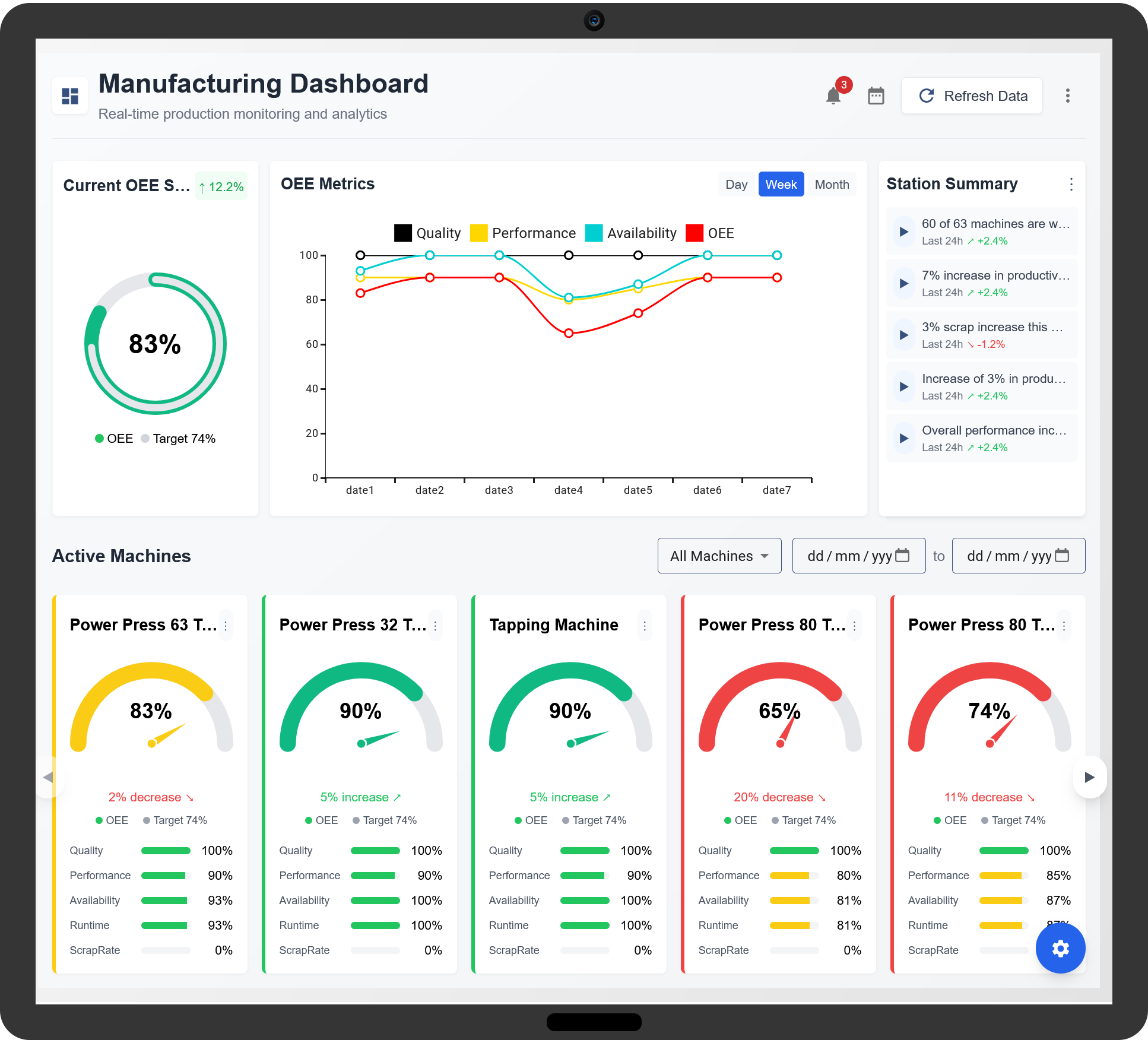Overall Equipment Effectiveness (OEE) is a crucial metric in textile manufacturing, helping businesses measure and enhance efficiency across production lines. In an industry where speed, quality, and cost-effectiveness are vital, improving OEE ensures better resource utilization, reduced waste, and higher profitability.

1. Key Components of OEE in Textile Manufacturing
- Availability: Ensures that machines operate during planned production time by reducing downtime.
- Performance: Tracks whether machines run at optimal speed without slow cycles or stoppages.
- Quality: Measures the number of defect-free textile products produced compared to total production.
2. How to Improve OEE in Textile Manufacturing
Step 1: Implement Real-Time Performance Monitoring
Use automated tracking systems to monitor machine availability, speed, and output in real time.
Step 2: Reduce Downtime with Preventive Maintenance
Schedule regular machine maintenance to minimize unplanned breakdowns and extend equipment lifespan.
Step 3: Optimize Production Line Efficiency
Adjust machine settings and streamline workflows to eliminate inefficiencies and increase output rates.
Step 4: Enhance Quality Control Measures
Introduce strict quality checks and use advanced inspection techniques to reduce defective products.
Step 5: Train Employees for Better Machine Handling
Provide operators with continuous training on best practices to ensure machines are used efficiently.
3. Benefits of Implementing OEE in Textile Manufacturing
- Higher Production Efficiency: Reduces idle time and maximizes machine utilization.
- Lower Defect Rates: Ensures consistent textile quality and fewer reworks.
- Cost Savings: Minimizes material waste and energy consumption.
- Better Resource Utilization: Improves workforce productivity and machine efficiency.
- Data-Driven Decision Making: Uses OEE analytics to drive continuous process improvements.
4. Future of OEE in Textile Manufacturing
With advancements in IoT, automation, and AI, textile manufacturers can further improve OEE through predictive maintenance, real-time tracking, and intelligent process optimization. These innovations will help the industry achieve higher efficiency, lower costs, and sustainable production practices.
By focusing on OEE, textile manufacturers can enhance productivity, ensure consistent quality, and remain competitive in a fast-evolving industry.
OEE in Textile Manufacturing
What is OEE in textile manufacturing?
OEE (Overall Equipment Effectiveness) in textile manufacturing is a key metric used to measure machine availability, performance efficiency, and product quality.
Why is OEE important in the textile industry?
OEE helps textile manufacturers improve machine utilization, minimize waste, and enhance overall production efficiency.
How is OEE calculated in textile production?
OEE is calculated using the formula: Availability × Performance × Quality, where each factor represents a key area of operational efficiency.
What are the key challenges in improving OEE for textiles?
Challenges include machine breakdowns, material inconsistencies, labor inefficiencies, and maintaining consistent production quality.
How does OEE help reduce machine downtime in textiles?
By tracking downtime causes and analyzing production data, OEE helps identify and resolve inefficiencies that lead to delays.
Can OEE software integrate with textile manufacturing systems?
Yes, OEE software can be integrated with ERP and MES systems to provide real-time monitoring and production analytics.
How does OEE improve machine efficiency in textile mills?
OEE tracks machine performance, identifies slowdowns, and provides insights to optimize efficiency in textile production.
What role does OEE play in textile quality control?
OEE helps maintain high quality by identifying defect trends and ensuring that production meets required standards.
How does OEE support predictive maintenance in textile factories?
By analyzing equipment data, OEE enables predictive maintenance, reducing unexpected failures and improving uptime.
Can OEE help optimize textile production schedules?
Yes, OEE provides real-time insights into machine performance, allowing for better production planning and resource allocation.
What are common causes of downtime in textile manufacturing?
Common causes include mechanical failures, unplanned maintenance, material shortages, and inefficient changeovers.
How does OEE impact cost savings in textile production?
By reducing downtime, improving efficiency, and minimizing waste, OEE contributes to significant cost savings.
What are the best practices for improving OEE in textile manufacturing?
Best practices include regular equipment maintenance, staff training, real-time monitoring, and process optimization.
How can OEE help track energy efficiency in textile production?
OEE data can be used to monitor energy usage, helping manufacturers reduce waste and improve sustainability.
Is OEE applicable to both small and large textile manufacturers?
Yes, OEE principles can be implemented in both small and large textile factories to improve productivity and efficiency.